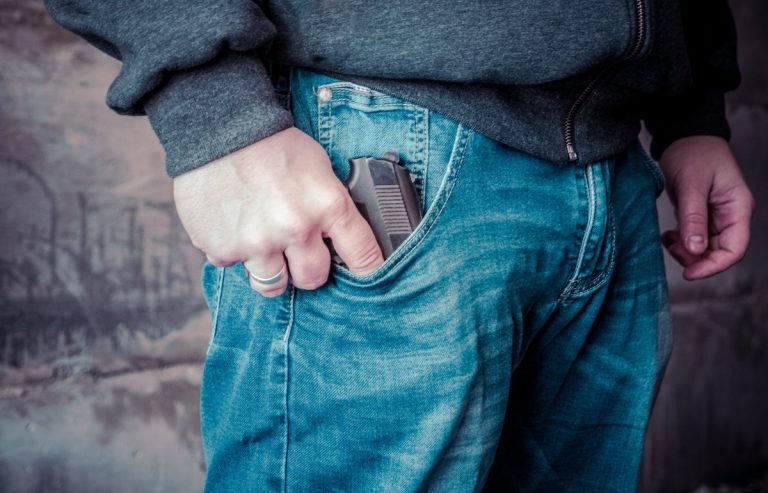On Feb. 24, 2015, a jury found Eddie Ray Routh guilty of murder. It took the jury about three hours to convict Routh for the killings of Chris Kyle and Chad Littlefield. The former Marine was sentenced to life imprisonment with no parole.
Who is Eddie Ray Routh? Why does Chris Kyle’s name seem familiar? And why, in a capital murder case, was Routh not given the death penalty?
Who is Eddie Ray Routh?
Eddie Ray Routh gained public attention as the man involved in the tragic events that led to the deaths of Chris Kyle and Chad Littlefield. Born on August 10, 1987, Routh hailed from Texas. His life took a tragic turn when he fatally shot renowned Navy SEAL sniper Chris Kyle and his friend Chad Littlefield at a shooting range in February 2013.
The incident occurred while Kyle tried to help Routh, struggling with post-traumatic stress disorder (PTSD). Routh’s troubled history, coupled with his military background and association with the victims, intensified public interest in his case.
The trial that followed delved into Routh’s mental health, his strained relationship with his family, and the impact of his military service. The verdict ultimately found Routh guilty of murder, leading to his imprisonment. Despite the media attention surrounding the trial, the story of Eddie Ray Routh serves as a reminder of the complexities of mental health, the challenges veterans face, and the devastating consequences of untreated trauma.
What Happened to Eddie Ray?
Eddie Ray Routh was an armorer for the Marine Corps in the late 2000s. On 2010, Routh was deployed to Haiti as part of a humanitarian mission, helping the earthquake-struck island. After returning from his deployment, Routh appeared to be deeply troubled. He reportedly told his father, Raymond, of his harrowing experience in recovering hundreds of bodies from the ocean and placing them in mass graves.
After serving the Marine Corps, Routh was honorably discharged in 2011. Soon, he began exhibiting troubling behavior. He had trouble holding onto a job and struggled with mental health issues. He was then admitted to the Dallas Veterans Administration Hospital where he was diagnosed with PTSD.
Who Killed Chris Kyle and Chad Littlefield?
The former Marine and Texas native rose to infamy after being charged with Chad Littlefield’s and Chris Kyle’s deaths.
Eddie Ray’s subsequent bouts with depression, marijuana use and alcoholism would figure in his trial as part of his criminal defense attorney’s strategy. The former Marine pleaded not guilty by reason of insanity during his arraignment.
Routh admitted to killing Chris Kyle and Chad Littlefield on Feb. 2, 2013 at a shooting range in Erath County, Texas. But his defense lawyer argued Routh was in a medically diagnosed psychosis at the time of the killings.
Since he was not in complete possession of his faculties, he was not legally responsible for his actions.
The night before Kyle and Littlefield took Routh at the shooting range for what would have been bonding time with another vet, he had been drinking and smoking marijuana.
But the jury did not absolve Routh of criminal responsibility. They found Routh was responsible for his actions and that, at the time of the killings, he knew that what he was doing was wrong.
Why Did the Insanity Defense Fail?
The insanity defense, a legal strategy used to argue that a defendant should not be held criminally responsible for their actions due to a mental illness, ultimately failed in Eddie Ray Routh’s case. Several factors contributed to the failure of the insanity defense:
- Burden of Proof: In the United States, the burden of proof lies with the defense to establish that the defendant was legally insane at the time of the crime. Routh’s defense team had to demonstrate that he suffered from a severe mental illness that impaired his ability to understand the nature and consequences of his actions. But due to insufficient medical evidence, the defense could not prove Routh’s mental state at the time of the shooting.
- Expert Testimony: Expert witnesses are crucial in an insanity defense case. Routh’s defense presented testimony from mental health professionals who diagnosed him with PTSD and claimed he was experiencing a psychotic episode during the shooting. However, the prosecution challenged these claims with their experts, creating conflicting narratives for the jury to consider.
- Lack of Evidence: Establishing a clear link between Routh’s mental state and his actions at the time of the crime proved challenging. Despite Routh’s documented history of mental health issues and his diagnosis of PTSD, proving that he was legally insane at the precise moment of the shooting was a significant hurdle.
- Counterarguments: The prosecution countered the insanity defense by highlighting evidence that suggested Routh was aware of the wrongfulness of his actions. This included Routh’s attempts to evade arrest and his statements to the police after the incident, indicating some understanding.
- Jury Decision: Ultimately, the jury determined that Routh did not meet the legal criteria for an insanity defense. They found him guilty of murder, suggesting that they believed he knew what he was doing at the time of the crime and should be held accountable.
The failure of the insanity defense in Routh’s case underscores the difficulty of proving legal insanity in a court of law, especially when confronted with conflicting evidence and interpretations of mental health issues.
How Did Chad Littlefield and Chris Kyle Die?

If Chris Kyle’s name seems familiar, it’s because of his biopic “American Sniper.” The Clint Eastwood-directed movie, which starred Brad Cooper as Kyle, was nominated for best film in the Oscars. The film, released in 2014, was loosely based on Kyle’s bestselling autobiography of the same title (released in 2012).
Kyle is known for having the most confirmed kills during the war in Iraq. The former U.S. Navy Seal was a sniper and served four tours. Honorably discharged in 2009, Kyle began working with a nonprofit that provides free in-home fitness equipment, personal training and life coaching to vets with disabilities or those suffering from PTSD.
Routh was not part of that program from FITCO Cares Foundation. But his mother approached Kyle and asked for his help. Kyle then asked for his fitness buddy and neighbor’s help, Chad Littlefield. Both invited Routh to the shooting range, hoping it’ll have a therapeutic effect on the former Marine.
According to text messages entered into evidence during the murder trial, Kyle had already sensed tension from Routh. At one point, the former Navy Seal referred to Routh as being “straight up nuts,” which the defense lawyer used to support his insanity strategy.
Routh shot Littlefield first, putting six bullets in him using a SIG Sauer P226. He then turned to Kyle and shot him seven times with a .45 caliber pistol. Both Kyle and Littlefield were armed, but their guns were still holstered with their safety caches on. Routh left the scene, taking both victims’ guns.
What Does Capital Crime Mean?
A capital offense is a crime punishable by death. In Texas, the offense is described in Section 19.03 of the Penal Code and is also known as “Lauren’s Law.”
Being charged with a capital crime means you’ve committed an offense with special circumstances. Those circumstances, according to Texas law, will include, intentionally committing “murder in the course of committing or attempting to commit kidnapping, burglary, robbery, aggravated sexual assault, arson, obstruction or retaliation, or terroristic threat.”
Although capital murder is one of the most serious offenses in Texas, the accused often gets bail. In Eddie Ray Routh’s case, the judge ordered $3 million in bond. Since the amount of bail was beyond Routh’s resources, he remained in custody at the Erath County Jail.
In other cases, accused people have committed other crimes while out on bond for capital offenses. But the amounts for such cases only reached a maximum of $500,000.
A capital murder case generally receives death penalty as punishment. “Generally” because not all prosecuting attorneys seek the death penalty. In Routh’s case, the district attorney did not pursue that punishment and instead opted for life imprisonment without the possibility of parole.
Where is Eddie Ray Routh Now?
After being convicted in 2013, Routh is currently serving his life sentence at the Louis Powledge Unit. It’s a medium-security prison in Palestine, Texas.
In 2017, Routh lost a Motion for Rehearing with the Texas 11th Court of Appeals. The appeals court rejected Routh’s insanity defense and claims of errors during the trial. One of these include a statement made to a Texas Ranger, which Routh’s lawyer argued, should have been a ground for a mistrial during the 10-day trial.
Routh’s defense lawyer ended representation soon after the rehearing was rejected.
Eddie Ray Routh still has other options for appeals, but nothing has been reported about new filings on his behalf.
Impact of the Case on Public Perception
The case involving Eddie Ray Routh had a profound impact on public perception, eliciting various reactions and highlighting several key aspects:
PTSD and Mental Health
The case brought significant attention to post-traumatic stress disorder (PTSD) and its effects on individuals, particularly military veterans. Routh’s history of mental health struggles, combined with his military service, sparked discussions about the mental toll of combat and the challenges faced by returning veterans. It sheds light on the need for better mental health support and treatment for those grappling with PTSD.
Tragic Loss of Chris Kyle
The case also put a spotlight on the tragic loss of Chris Kyle, a highly decorated Navy SEAL sniper, and the subject of the book and subsequent film “American Sniper.” Kyle’s reputation as a skilled marksman and his contributions to the military community made his death deeply impactful. The case emphasized the risks those in the armed forces faced and generated widespread sympathy for Kyle’s family and friends.
Public Safety and Gun Control
The incident sparked debates surrounding gun control and public safety. Questions arose about the accessibility of firearms to individuals with mental health issues and the responsibility of gun owners to prevent potential harm. The case supported discussions on balancing individual rights with public safety measures.
Legal System and the Insanity Defense
The trial prompted discussions about the legal system’s treatment of individuals with mental illnesses and the effectiveness of the insanity defense. It raised questions about the burden of proof, the role of expert testimony, and the challenges faced by defense attorneys when presenting a mental health-based defense. The case spurred debates on whether reforms were necessary to address these complexities.
Media Coverage and Discussions Surrounding Eddie Ray Routh
The case of Eddie Ray Routh garnered extensive media coverage and sparked numerous discussions across various platforms. Here are some critical aspects of the media coverage and controversies surrounding Routh:
Sensationalism and Public Interest
The high-profile nature of the case attracted significant media attention. News outlets, both local and national, closely followed the trial proceedings and provided regular updates. The sensationalized aspects of the story, including the involvement of a decorated Navy SEAL sniper and the tragic loss of life, fueled public interest and drew widespread coverage.
Public Perception and Sympathy
Media coverage influenced public perception of Routh, Kyle, and the events surrounding the case. Different narratives emerged, with some sympathizing with Routh’s struggles with mental health and others emphasizing the loss of a decorated military veteran like Chris Kyle. The case served as a backdrop for broader discussions on compassion, understanding, and the complexities of individual responsibility within the criminal justice system.
The case of Eddie Ray Routh captivated public attention, leading to discussions about mental health, the legal system, gun control, and public safety. Through media coverage, it shed light on the complexities of PTSD, the challenges faced by veterans, the intricacies of the insanity defense, and the delicate balance between individual rights and public welfare. The case served as a catalyst for meaningful conversations, emphasizing the importance of addressing mental health issues, improving support for veterans, and finding balanced solutions to societal challenges.







